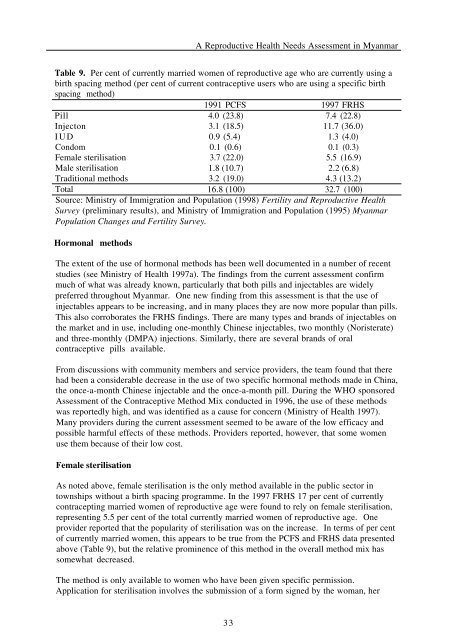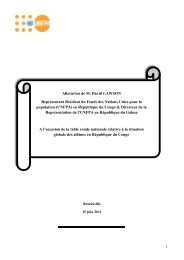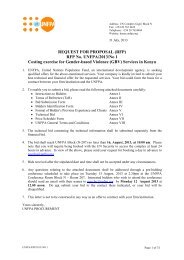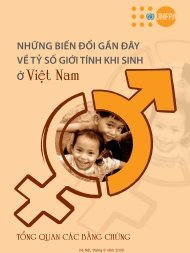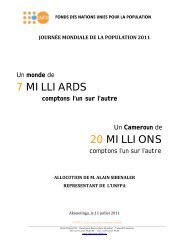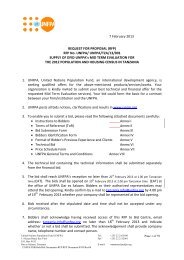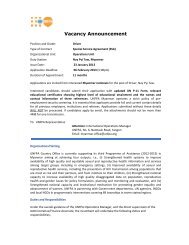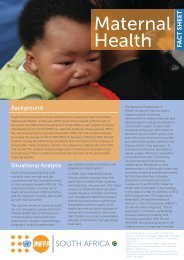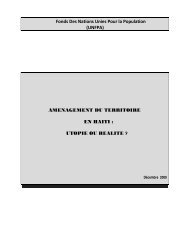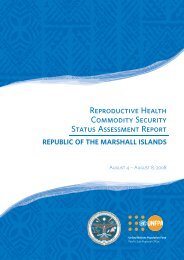A reproductive health needs assessment in Myanmar
A reproductive health needs assessment in Myanmar
A reproductive health needs assessment in Myanmar
You also want an ePaper? Increase the reach of your titles
YUMPU automatically turns print PDFs into web optimized ePapers that Google loves.
A Reproductive Health Needs Assessment <strong>in</strong> <strong>Myanmar</strong><br />
Table 9. Per cent of currently married women of <strong>reproductive</strong> age who are currently us<strong>in</strong>g a<br />
birth spac<strong>in</strong>g method (per cent of current contraceptive users who are us<strong>in</strong>g a specific birth<br />
spac<strong>in</strong>g method)<br />
1991 PCFS 1997 FRHS<br />
Pill 4.0 (23.8) 7.4 (22.8)<br />
Injecton 3.1 (18.5) 11.7 (36.0)<br />
I U D 0.9 (5.4) 1.3 (4.0)<br />
Condom 0.1 (0.6) 0.1 (0.3)<br />
Female sterilisation 3.7 (22.0) 5.5 (16.9)<br />
Male sterilisation 1.8 (10.7) 2.2 (6.8)<br />
Traditional methods 3.2 (19.0) 4.3 (13.2)<br />
Total 16.8 (100) 32.7 (100)<br />
Source: M<strong>in</strong>istry of Immigration and Population (1998) Fertility and Reproductive Health<br />
Survey (prelim<strong>in</strong>ary results), and M<strong>in</strong>istry of Immigration and Population (1995) <strong>Myanmar</strong><br />
Population Changes and Fertility Survey.<br />
Hormonal methods<br />
The extent of the use of hormonal methods has been well documented <strong>in</strong> a number of recent<br />
studies (see M<strong>in</strong>istry of Health 1997a). The f<strong>in</strong>d<strong>in</strong>gs from the current <strong>assessment</strong> confirm<br />
much of what was already known, particularly that both pills and <strong>in</strong>jectables are widely<br />
preferred throughout <strong>Myanmar</strong>. One new f<strong>in</strong>d<strong>in</strong>g from this <strong>assessment</strong> is that the use of<br />
<strong>in</strong>jectables appears to be <strong>in</strong>creas<strong>in</strong>g, and <strong>in</strong> many places they are now more popular than pills.<br />
This also corroborates the FRHS f<strong>in</strong>d<strong>in</strong>gs. There are many types and brands of <strong>in</strong>jectables on<br />
the market and <strong>in</strong> use, <strong>in</strong>clud<strong>in</strong>g one-monthly Ch<strong>in</strong>ese <strong>in</strong>jectables, two monthly (Noristerate)<br />
and three-monthly (DMPA) <strong>in</strong>jections. Similarly, there are several brands of oral<br />
contraceptive pills available.<br />
From discussions with community members and service providers, the team found that there<br />
had been a considerable decrease <strong>in</strong> the use of two specific hormonal methods made <strong>in</strong> Ch<strong>in</strong>a,<br />
the once-a-month Ch<strong>in</strong>ese <strong>in</strong>jectable and the once-a-month pill. Dur<strong>in</strong>g the WHO sponsored<br />
Assessment of the Contraceptive Method Mix conducted <strong>in</strong> 1996, the use of these methods<br />
was reportedly high, and was identified as a cause for concern (M<strong>in</strong>istry of Health 1997).<br />
Many providers dur<strong>in</strong>g the current <strong>assessment</strong> seemed to be aware of the low efficacy and<br />
possible harmful effects of these methods. Providers reported, however, that some women<br />
use them because of their low cost.<br />
Female sterilisation<br />
As noted above, female sterilisation is the only method available <strong>in</strong> the public sector <strong>in</strong><br />
townships without a birth spac<strong>in</strong>g programme. In the 1997 FRHS 17 per cent of currently<br />
contracept<strong>in</strong>g married women of <strong>reproductive</strong> age were found to rely on female sterilisation,<br />
represent<strong>in</strong>g 5.5 per cent of the total currently married women of <strong>reproductive</strong> age. One<br />
provider reported that the popularity of sterilisation was on the <strong>in</strong>crease. In terms of per cent<br />
of currently married women, this appears to be true from the PCFS and FRHS data presented<br />
above (Table 9), but the relative prom<strong>in</strong>ence of this method <strong>in</strong> the overall method mix has<br />
somewhat decreased.<br />
The method is only available to women who have been given specific permission.<br />
Application for sterilisation <strong>in</strong>volves the submission of a form signed by the woman, her<br />
33


